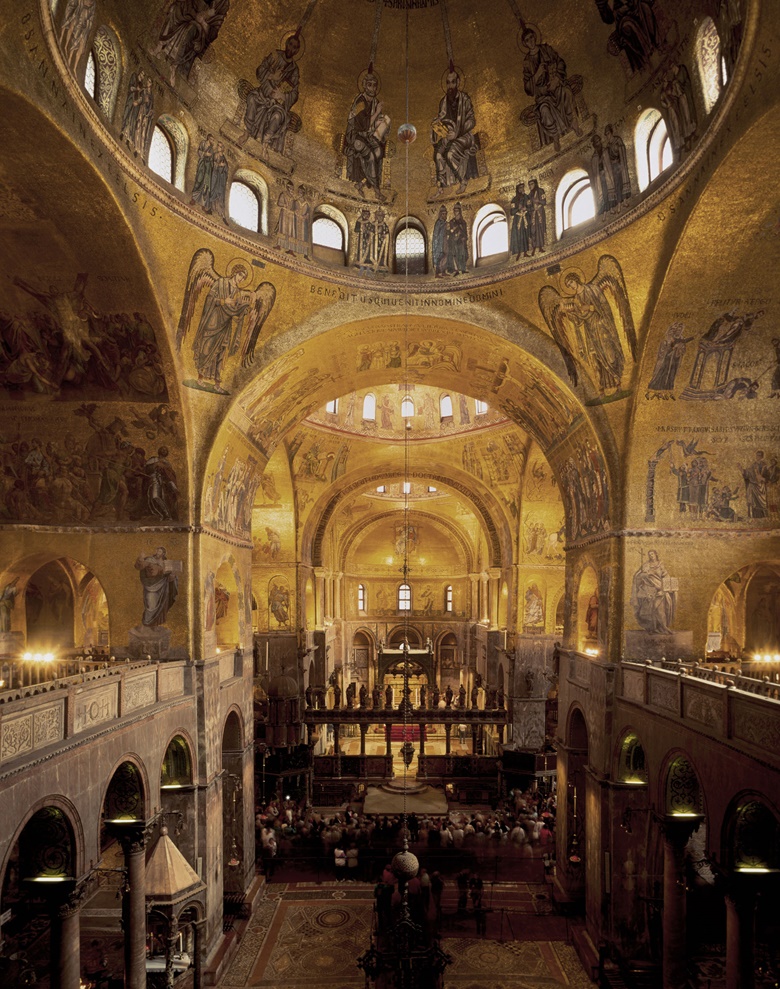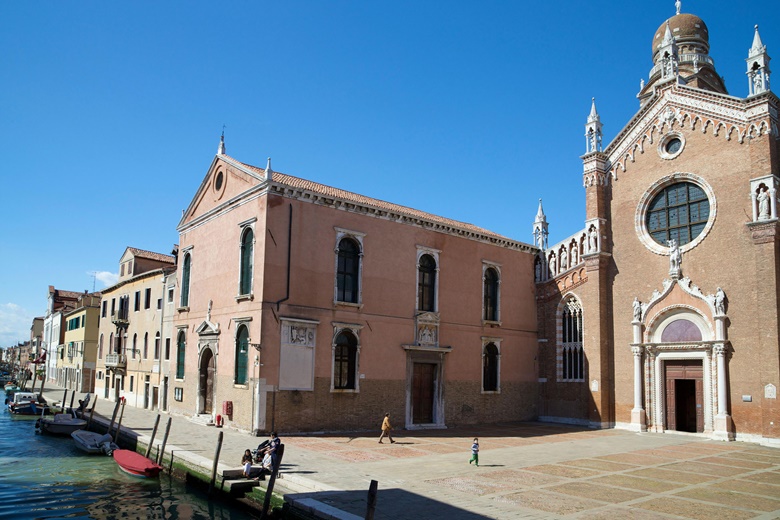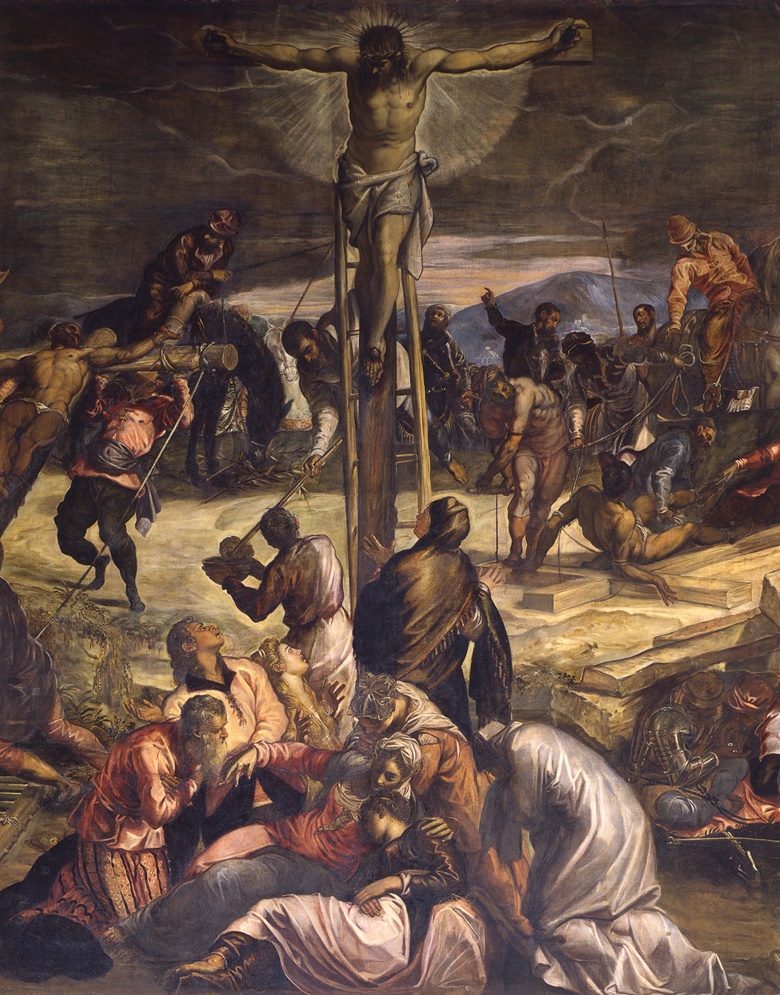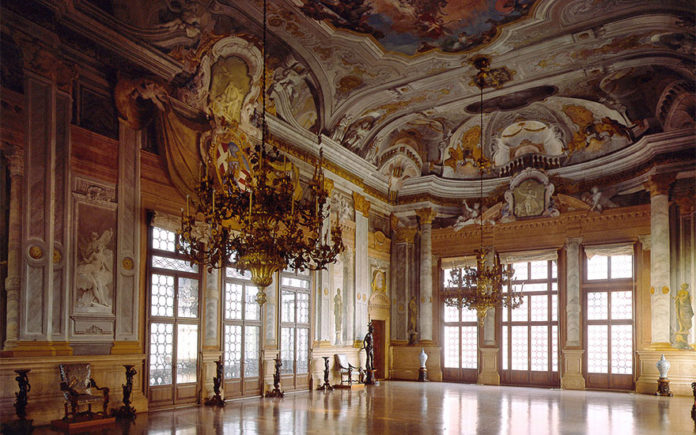Of course, there is so much art to experience in Venice beyond the Biennale. Your guides are Christie’s Old Masters specialists Francis Russell and Nicholas Hall

‘The spiritual and emotional centre of Venice’ — the interior of St Mark’s Basilica © Michael Harding / Alamy
Francis Russell: St Mark’s Basilica is the spiritual, indeed the emotional, centre of Venice. The wonderful drama of its façade and domes and the measured rhythm of the interior impress immediately; the remarkable mosaics take much longer to digest.
The magic of the place is most palpable in the early morning, when those who want to pray can visit the north transept. But return later to wonder at such miracles as the Pala d’Oro, the jewel-studded altarfront. The treasury must be the most remarkable in Italy, and the panels by Paolo Veneziano in the museum mark the highpoint of Gothic painting in Venice.
Nicholas Hall: This painting — housed in the Scuola di San Giorgio degli Schiavoni — and the extraordinary cycle around it painted by Vittore Carpaccio, was the work that first got me hooked on Italian art as a seven-year-old boy. Painted on a massive scale — the canvas measures 360 cm in width — it depicts the determined saint in a suit of gleaming black armour transfixing the ferocious dragon on the point of his lance.
In this perfectly balanced composition the action, intense as it is, seems for ever frozen in time; the figures almost heraldic. Carpaccio sets the scene and indulges in his fascination with the depiction of special depth with a gruesome tableau of skulls, snakes and the foreshortened half-eaten corpses of the dragon’s previous victims. Behind the saint recedes a fantasmagorical landscape with strange rock formations which would have made Chinese literati feel at home.

The church of Madonna dell’Orto, home to Cima’s St John the Baptist with Other Saints © Peter Barritt / Alamy
FR: The church of Madonna dell’Orto is a majestic late Gothic brick church, memorable not least for its pictures. Cima’s Saint John the Baptist with Other Saints is as sharp in detail as any relief by the Lombardo and perfectly controlled in colour, while Tintoretto is found at his most cerebral — in the Presentation of the Virgin — and at his most visionary — in the Last Judgement of the choir.
FR: The Accademia must take pride of place among the museums of Venice. For there, as nowhere else, the miraculous kaleidoscope of Venetian painting from Paolo and Lorenzo Veneziano to Rosalba Carriera and Guardi can be surveyed.
Go early and linger for as long as possible in the small rooms for the Bellini Madonnas, his Donà delle Rose Pietà and Giorgione’s Tempesta. But do not neglect the less intimate masterpieces, Bellini’s San Giobbe altarpiece, the haunting late Titian Lamentation, the major works by Veronese and Tintoretto, or Carpaccio’s grandest achievement, the sequence of canvases of the life of Saint Ursula.

The Museo Correr, which can be found on the south side of St Mark’s Square © Fondazione Musei Civici di Venezia — Foto di Graziano Arici
FR: The Museo Correr, Venice’s civic museum, is also remarkable: the Bellinis there can still be seen in natural side light, as the artist would have expected.
The Ca’ d’Oro on the Grand Canal is the most elegant of early 15th-century Venetian palaces. Alas, the ruthless recent reorganisation of the collection means that one can no longer sense the tact with which Barone Franchetti treated the house before he bequeathed it to the state in 1916.
The institutional fate of Ca’ Rezzonico, the greatest of the 18th-century palaces, also on the Grand Canal, has been kinder: the collection of Settecento pictures, furniture and sculptures perfectly complements the building.
FR: Santa Maria Gloriosa dei Frari is a vast late Gothic Franciscan church and the building is well named: its brick apses are without rival, and the campanile only exceeded in height by that of Saint Mark’s.
The sustained richness of the interior is almost impossible to describe. The choir is dominated by Titian’s triumphant Assumption, a work of unparalleled ambition. Later, by 1526, the artist would supply his equally remarkable — and in some ways more influential — altarpiece for the Pesaro family. The two pictures were potent statements of an artistic revolution that owed so much to the painter’s early mentor, Bellini, whose incomparable triptych of 1488 in the sacristy, still in its proper frame, had in turn been revolutionary in its day.
Other major Venetian churches are rich in sculpture, but none competes in range perhaps with the Frari, for impressive state monuments to public figures are complemented by Donatello’s spare Saint Jean de Baptist and Canova’s pyramidal memorial to Titian.

Detail of Tintoretto’s ‘prodigious’ Crucifixion, painted in 1565 © Bridgeman
FR: The Scuola Grande di San Rocco, just behind the Frari, is one of the grandest of Venice’s institutions. The building was begun in 1515, but in view of its scale it is not surprising that work proceeded slowly.
The lower hall, vast and tenebrous, is adorned by a series of eight canvases by Tintoretto, all but two drawn from the New Testament. Tintoretto was also responsible for the ceiling compartments and 12 further scenes from the life of Christ of the upper hall and the ceiling, and Passion scenes of the adjacent hostel, culminating in the prodigious Crucifixion.
Tintoretto as a portrait painter was truthful and objective; as a religious master he is no less truthful. He has a force that demonstrates that his study of models after Michelangelo had not been in vain. But his sense of drama is his own. And his technical abilities were perfectly calibrated for the project.
FR: At Santa Maria del Carmelo a supply of coins is necessary to illuminate Cima’s tender Nativity of c. 1509 and Lotto’s Saint Nicholas in Glory with its irresistible landscapes. If a sacristan is about, ask to see the bronze relief of the Deposition with portraits of members of the Montefeltro family by the Sienese Francesco di Giorgio, located in the right apse.
NH: Over a period of 20 years, beginning in 1555, Veronese decorated the entire church of San Sebastiano, from the sacristy to the organ shutters to the main altarpiece and, above all (literally), the superb ceilings. For me the Triumph of Mordecai, which dominates the ceiling of the nave, is one of the most dramatic passages of painting of the Venetian Renaissance.
Against a vertiginous brick edifice the central characters, Mordecai, Haman and Ahasuerus, seem to tip into our space propelled by two huge horses, one black and one white, whose massive hooves paw the air. It is a painting of ravishing colour and raw energy. It is a painting about the triumph of loyalty and the public humiliation of evil. With its mass of onlookers and the complex interchange of glances between the main actors in the drama, it is also a painting about looking. And it is well worth the slight strain of twisting one’s head to look upwards at this magnificent painting.
FR: Veronese’s enduring legacy can be experienced at Giorgio Massari’s Santa Maria dei Gesuati, which may be the most ambitious church of 18th-century Venice. The ceiling was frescoed by Giovanni Battista Tiepolo, whose three compositions perfectly complement the architecture and stucco decoration. For altarpieces, the three dominant masters of the time were called in.
Sebastiano Ricci’s Pius V with Saints Thomas Aquinas and Peter Martyr on the left is a late tribute to Veronese. This was followed by Piazzetta’s luminous and subtle Saints Vincent Ferrer, Louis Bertrand and Hyacinth, the restrained colour of which reads almost like a rejection of Ricci’s homage to the Venetian past. Tiepolo’s beautiful Madonna and Child with Saints Catherine, Rosa of Lima and Agnes, above the first altar on the right, is perhaps his happier statement as a religious painter.
NH: Inside this extraordinary church is installed one of Titian’s greatest masterpieces, his massive Martyrdom of St Lawrence. It is a dazzling nocturne, almost monochromatic except for an imperial standard and some draperies. Against the inky sky, a celestial light breaks through the clouds; torches punctuate the composition and lead the eye down toward the central action where a group of burly soldiers submit Saint Lawrence to his terrible martyrdom above the primary light source, the flaming bed of coals. A monumental dramatic work, it is nevertheless filled with a personal humanity.

























